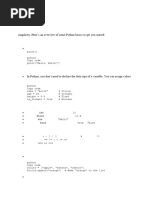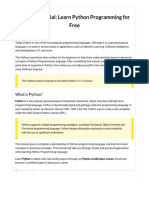0 ratings0% found this document useful (0 votes)
6 viewsPython_Programming_Guide
Uploaded by
Bhumik HingveCopyright
© © All Rights Reserved
Available Formats
Download as PDF, TXT or read online on Scribd
0 ratings0% found this document useful (0 votes)
6 viewsPython_Programming_Guide
Uploaded by
Bhumik HingveCopyright
© © All Rights Reserved
Available Formats
Download as PDF, TXT or read online on Scribd
You are on page 1/ 2
Introduction to Python Programming
Python is a versatile programming language that is widely used in various fields, including web
development, data science, artificial intelligence, and more. This guide introduces the basics of
Python for beginners.
1. Key Features of Python:
- Easy to learn and use
- Extensive libraries and frameworks
- Cross-platform compatibility
- Support for multiple programming paradigms
2. Basic Syntax:
Python uses indentation to define blocks of code instead of braces or keywords. Example:
if True:
print('Hello, World!')
3. Data Types:
- Numbers (int, float, complex)
- Strings ('hello', "world")
- Lists ([1, 2, 3])
- Dictionaries ({'key': 'value'})
- Tuples ((1, 2, 3))
4. Functions:
Functions in Python are defined using the 'def' keyword. Example:
def greet(name):
return f'Hello, {name}!'
5. Libraries:
Popular Python libraries include:
- NumPy: Numerical computing
- Pandas: Data manipulation
- Matplotlib: Data visualization
- TensorFlow: Machine learning
This document provides a foundational understanding of Python, setting the stage for more
advanced learning.
You might also like
- Trenton M. Python Programming Bible For Beginners. (4 in 1) ... Crash Course... 2024No ratings yetTrenton M. Python Programming Bible For Beginners. (4 in 1) ... Crash Course... 2024148 pages
- Python Programming Basics – A Beginner’s GuideNo ratings yetPython Programming Basics – A Beginner’s Guide2 pages
- 2 Minutes Crash Course on Python for BegineersNo ratings yet2 Minutes Crash Course on Python for Begineers6 pages
- Presentation Topic On Introduction of PythonNo ratings yetPresentation Topic On Introduction of Python9 pages
- Python Programming For Beginner - Jackson, KitNo ratings yetPython Programming For Beginner - Jackson, Kit311 pages
- Python Primer: Introduction To Python Programming: Getting Sta TedNo ratings yetPython Primer: Introduction To Python Programming: Getting Sta Ted7 pages
- Explain Everything About Python Programming From...No ratings yetExplain Everything About Python Programming From...3 pages
- Chris Ford - Learn Python Programming Quickly (2021)100% (1)Chris Ford - Learn Python Programming Quickly (2021)209 pages
- Introduction to Python Programming A Step-by-Step GuideNo ratings yetIntroduction to Python Programming A Step-by-Step Guide1 page
- Python Primer - A Self Study Approach by Bibek BhandariNo ratings yetPython Primer - A Self Study Approach by Bibek Bhandari89 pages
- Python Tutorial - Learn Python Programming For FreeNo ratings yetPython Tutorial - Learn Python Programming For Free6 pages
- slidesgo-unraveling-python-a-beginners-guide-to-the-versatile-programming-language-20241202083846RiwGNo ratings yetslidesgo-unraveling-python-a-beginners-guide-to-the-versatile-programming-language-20241202083846RiwG7 pages
- Python Programming For Beginners - Learn Python Programming in 24 Hours PDF100% (21)Python Programming For Beginners - Learn Python Programming in 24 Hours PDF133 pages
- Mastering Python Programming: A Comprehensive Guide: The IT CollectionFrom EverandMastering Python Programming: A Comprehensive Guide: The IT Collection5/5 (1)
- Python programming for beginners: Python programming for beginners by Tanjimul Islam TareqFrom EverandPython programming for beginners: Python programming for beginners by Tanjimul Islam TareqNo ratings yet
- Class 10 MCQ's Additional Question Paper and Sample Paper 2024No ratings yetClass 10 MCQ's Additional Question Paper and Sample Paper 202465 pages
- UDAAN 2024: Foundation Batch For Class-10th English Lecture PlannerNo ratings yetUDAAN 2024: Foundation Batch For Class-10th English Lecture Planner2 pages
- DRI Calculator Results - National Agricultural LibraryNo ratings yetDRI Calculator Results - National Agricultural Library4 pages








































































